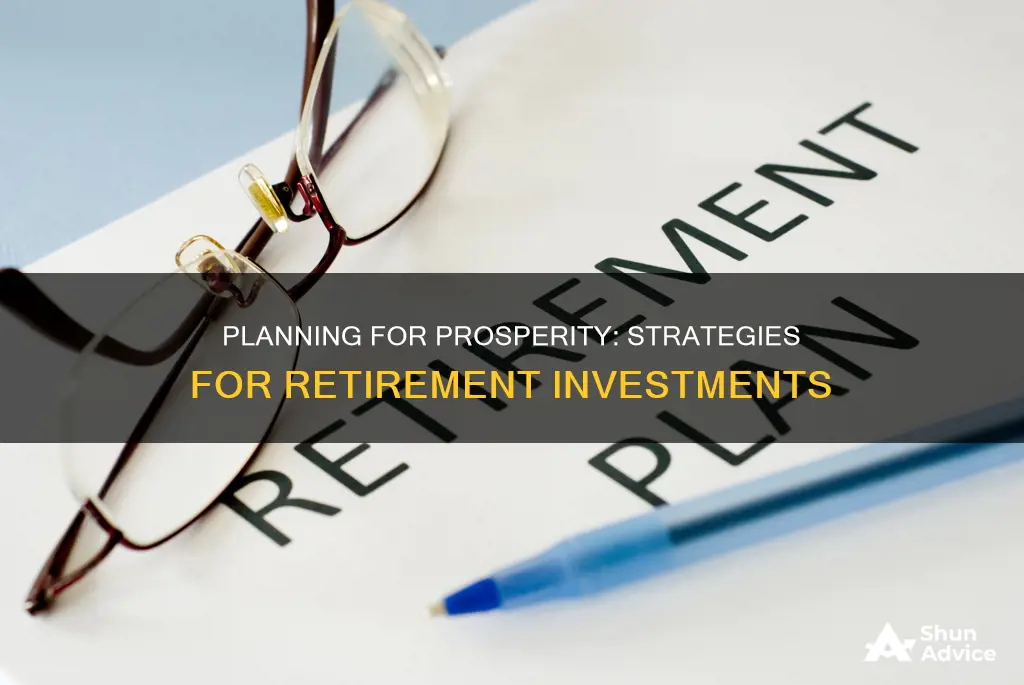
The five years before retirement is a critical time for planning. It's important to assess your financial situation and budget, factoring in expenses like healthcare, and determining how much money you'll need. It's also a good idea to increase your savings, embrace liquidity, and pay down debt. As you get closer to retirement, you should adjust your investment portfolio to reduce risk and protect your assets. This might include shifting to more conservative investments, such as bonds, annuities, and income-producing equities, or diversifying your portfolio to hedge against inflation. It's also crucial to plan for Social Security and future healthcare costs, as well as consider tax-smart strategies.
What You'll Learn

Assess your situation and budget
If you're five years away from retirement, it's crucial to assess your situation and budget. Here are some steps to help you do that:
Review your retirement plan:
Even if you're close to retirement, don't panic. It's never too late to make or adjust your plan. Consider how much money you'll need, what kind of investments are appropriate, and what kind of lifestyle you want after retiring.
Evaluate your budget:
Go through your budget carefully and cut any discretionary expenses that aren't essential. Be sure to include increased costs, such as healthcare, in your plans, as these expenses can have a significant impact on your overall financial health during retirement.
Understand your expenses:
Projecting your expenses during retirement can be relatively straightforward. Start by making a list of items or experiences you expect to spend money on and estimate their costs. You can use your current budget as a starting point and adjust it according to your retirement plans. For example, you may eliminate or reduce expenses related to commuting to work and increase allocations for travel or hobbies.
Estimate your income:
Add up the income you're guaranteed to receive during retirement. This includes Social Security benefits, pension income, annuity payments, property sales or rentals, and any other savings or assets you can draw on.
Do a retirement needs analysis:
Failing to do a proper retirement needs analysis can lead to financial struggles during retirement. While a basic analysis might involve multiplying your current income by a recommended percentage (such as 75%-80%), it's important to take a holistic approach. Consider all aspects of your finances, including items that could affect your cash flow and expenditures.
Determine your life expectancy and insurance needs:
Estimate your life expectancy based on your general health and family history. Consider whether your family has been prone to costly, long-term illnesses, and if so, insuring your retirement assets and looking into long-term care insurance may be crucial.
In summary, assessing your situation and budget involves understanding your financial priorities, reviewing your budget, projecting expenses, estimating income, and planning for potential long-term care needs. By taking these steps, you can make informed decisions about your retirement and ensure that your financial plans are aligned with your goals and expectations.
The Crypto Conundrum: Navigating the Volatile World of Digital Currency Investments
You may want to see also

Increase your savings
If you're nearing retirement and haven't saved enough, it's a good idea to start increasing your retirement savings contributions. The earlier you start building financial security for later life, the better off you will be.
How much you should save depends on your current financial situation, how long you have until retirement, and your risk tolerance. If you have a longer timeframe until retirement, you will have more time to earn back any money lost in market downturns.
If you have an employer-sponsored account, such as a 401(k), 403(b), or Thrift Savings Plan, be sure to contribute at least enough to get the full amount of your employer's match. In 2024, you can contribute up to $23,000 to these accounts, and if you are 50 or older, you can make a catch-up contribution of $7,500, for a total of $30,500.
Once you've contributed to your employer account, or if you don't have one, consider contributing to a traditional or Roth IRA. In 2024, the contribution limit for these accounts is $7,000, and if you are 50 or older, you can make a catch-up contribution of $1,000.
If you're eligible, you can also use a Health Savings Account (HSA) to save for future healthcare costs. Catch-up contributions to HSAs are allowed starting the year you turn 55.
You can also save in a regular brokerage account, where there is no limit on how much you can save.
If you're not sure how much to save or which accounts to use, a financial advisor can help you create a plan that suits your needs and goals.
Paying Salaries: A Strategic Investment or a Necessary Expense?
You may want to see also

Embrace liquidity
Liquidity is a crucial consideration when it comes to retirement planning. Here are some key insights on embracing liquidity as you approach your retirement years:
Understand Liquidity
Liquidity refers to the ease with which an asset or security can be converted into cash without significantly affecting its market price. It describes how quickly and efficiently an asset can be turned back into cash. The most liquid asset is cash itself, while tangible items, such as real estate or collectibles, tend to be less liquid and may take more time and incur higher costs to sell.
The Benefits of Liquidity
Liquidity is advantageous for several reasons. Liquid assets are typically associated with lower fees, penalties, or transaction costs when converted to cash. They are also widely accepted and can be easily exchanged. Additionally, liquid assets often have public pricing, making them easier to value.
Focus on Liquid Investments
As you approach retirement, it's essential to review your investment portfolio and consider shifting to more conservative or lower-risk investments. While aggressive stocks or funds may offer higher returns, they also carry a greater risk of loss. Instead, consider investments that provide dividend income or fixed-income bonds.
Maintain an Emergency Fund
It's wise to have an emergency fund in place, consisting of highly liquid assets. Financial advisors often recommend keeping at least 3-6 months' worth of living expenses in a savings account, money market account, or liquid certificate of deposit (CD). This ensures that you have readily accessible funds to cover any unexpected expenses or financial emergencies.
Plan for Retirement Expenses
Create a detailed retirement spending plan by estimating your expected expenses during retirement. Consider travel plans, leisure activities, healthcare costs, and any other lifestyle changes you anticipate. This will help you determine how much income you'll need to maintain your desired standard of living.
Strive for Debt Freedom
As you approach retirement, make it a goal to minimise or eliminate high-interest debt. This includes credit card debt, mortgages, lines of credit, and auto loans. Reducing your debt burden will give you more financial flexibility during retirement and ensure that your retirement income is not weighed down by ongoing debt payments.
Be Mindful of Market Volatility
Highly liquid investments, such as oil, foreign currencies, and equities on international stock exchanges, can be extremely volatile. While they offer the advantage of quick trading, their prices can fluctuate sharply in response to specific events or changes in investor sentiment. Be cautious when investing in these assets, especially as you approach retirement, as you may not have sufficient time to recover from significant losses.
Diversify Your Portfolio
While liquidity is essential, it's also beneficial to maintain a balanced portfolio that includes both liquid and illiquid investments. Private equity investments, for example, tend to be more illiquid but can provide the benefit of reduced volatility and potentially higher returns over time. Consult with a financial advisor to ensure your portfolio aligns with your risk tolerance and retirement goals.
Is Your Investment Strategy Worth the Cost?
You may want to see also

Focus on paying down debt
Five years before retirement, it's important to focus on paying down debt. This means making a plan to tackle any existing debt and preventing new debt from accumulating. Here are some steps to help you focus on paying down debt in the five years leading up to your retirement:
Evaluate Your Debts
The first step is to get a clear picture of your debts. Make a list of all your debts, including credit card balances, car payments, student loans, and mortgages. Note down the balances, minimum monthly payments, and interest rates for each debt. This will help you understand the scope of your debt and prioritize high-interest debts.
Stop Accumulating Debt
To effectively reduce your debt, it's crucial to stop adding new debt. This may involve making some behavioural changes, such as stopping the use of credit cards. Be honest with yourself about your spending habits, and if necessary, make a budget and stick to it.
Prioritize High-Interest Debt
Focus on paying off debts with high-interest rates first. Credit card debt, for example, typically has very high-interest rates, and it is essential to prioritize paying this off. Make at least the minimum payments on all your cards, but target extra payments towards the card with the highest interest rate. Once that card is paid off, move on to the next highest-interest card.
Create a Debt Repayment Plan
Develop a strategy to repay your debts. The "debt snowball method" is a popular approach, where you focus on paying off the debt with the smallest balance first to gain a quick "win" and build momentum. Then, you roll that payment into the next smallest debt. This method can help keep you motivated as you see your debts being eliminated one by one.
Refinance or Downsize
If you're struggling to pay off your mortgage before retirement, consider refinancing to get a lower interest rate or a shorter loan term. Alternatively, you could downsize by selling your current home and using the proceeds to purchase a less expensive property outright, allowing you to enter retirement debt-free.
Seek Professional Advice
If you're feeling overwhelmed, consider seeking advice from a financial advisor or planner. They can help you assess your situation, create a realistic plan, and provide guidance on investing and debt management strategies.
Remember, the goal is to enter retirement with as little debt as possible. By focusing on paying down debt in the five years leading up to your retirement, you can improve your financial stability and reduce stress during your golden years.
Fidelity Investments: Unlocking Dividend Potential
You may want to see also

Shift your investments
When you're five years away from retirement, it's time to shift your investments to reduce risk and protect your finances from any potential losses due to market volatility. Here are some things to keep in mind:
Diversify your portfolio
Diversifying your portfolio is crucial to protect your investments and hedge against inflation. During market downturns, certain companies or industries tend to perform better than others, such as commodities, short-term bonds, and alternative investments like gold. However, don't put all your money into one company or industry to hedge your bets.
Reduce riskier investments
As you get closer to retirement, it's generally recommended to reduce riskier investments in favour of more stable options. This means moving away from growth-focused investments (equities) and towards protection-focused investments (balanced and fixed-income assets, bonds) so that you can use your investments for income soon.
Maintain some growth
While reducing risk is important, you still need to have some growth in your portfolio to keep up with inflation, especially if you intend to live for many years after retirement. A rule of thumb is to subtract your age from 100 and invest that percentage in equities. However, with increasing life expectancies, some advisors suggest subtracting your age from 110 or even 120.
Take advantage of mutual funds
Many investment companies offer mutual funds that automatically adjust your investments as you get older, based on your risk tolerance. These funds can help take the stress out of managing your investments as you approach retirement.
Review your investment portfolio regularly
It's important to review your investment portfolio at least once a year to ensure it aligns with your retirement goals and risk tolerance. As you get closer to retirement, you may want to shift to more conservative or lower-risk investments to protect your savings.
Seek professional guidance
Consider working with a financial advisor or tax professional to help you navigate the complexities of retirement planning, including tax implications, risk mitigation, and coordinating plans with a spouse or partner. They can provide valuable insights and guidance tailored to your specific circumstances.
Shares: Picking Winners
You may want to see also
Frequently asked questions
This depends on a number of factors, such as your expenses, income, and how long you expect to be retired for. As a rule of thumb, you should save up enough money to maintain your current lifestyle, which is typically somewhere between 70% to 80% of your current income.
It is recommended that you shift your investments from high-risk, high-growth assets like stocks to more stable, low-earning funds like bonds and cash reserves. This will help protect your finances from any potential losses due to market volatility.
It is important to assess your financial situation and budget, increase your savings, embrace liquidity, and focus on paying off any debt. You should also consider getting a head start on future healthcare costs and planning your retirement income.







